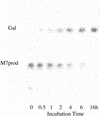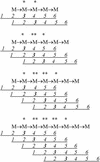Transfer specificity of detergent-solubilized fenugreek galactomannan galactosyltransferase
- PMID: 12114592
- PMCID: PMC166532
- DOI: 10.1104/pp.002592
Transfer specificity of detergent-solubilized fenugreek galactomannan galactosyltransferase
Abstract
The current experimental model for galactomannan biosynthesis in membrane-bound enzyme systems from developing legume-seed endosperms involves functional interaction between a GDP-mannose (Man) mannan synthase and a UDP-galactose (Gal) galactosyltransferase. The transfer specificity of the galactosyltransferase to the elongating mannan chain is critical in regulating the distribution and the degree of Gal substitution of the mannan backbone of the primary biosynthetic product. Detergent solubilization of the galactosyltransferase of fenugreek (Trigonella foenum-graecum) with retention of activity permitted the partial purification of the enzyme and the cloning and sequencing of the corresponding cDNA with proof of functional identity. We now document the positional specificity of transfer of ((14)C)Gal from UDP-((14)C)Gal to manno-oligosaccharide acceptors, chain lengths 5 to 8, catalyzed by the detergent-solubilized galactosyltransferase. Enzymatic fragmentation analyses of the labeled products showed that a single Gal residue was transferred per acceptor molecule, that the linkage was (1-->6)-alpha, and that there was transfer to alternative Man residues within the acceptor molecules. Analysis of the relative frequencies of transfer to alternative Man residues within acceptor oligosaccharides of different chain length allowed the deduction of the substrate subsite recognition requirement of the galactosyltransferase. The enzyme has a principal recognition sequence of six Man residues, with transfer of Gal to the third Man residue from the nonreducing end of the sequence. These observations are incorporated into a refined model for enzyme interaction in galactomannan biosynthesis.
Figures




References
-
- Bailey RW. Polysaccharides in the leguminosae. In: Harborne JB, Boulter D, Turner BL, editors. Chemotaxonomy of the Leguminosae. London: Academic Press; 1971. pp. 503–541.
-
- Dea ICM, Morrison A. Chemistry and interactions of seed galactomannans. Adv Carbohydr Chem Biochem. 1975;31:241–312.
-
- Dea ICM, Morris ER, Rees DA, Welsh EJ, Barnes HA, Price J. Associations of like and unlike polysaccharides: mechanism and specificity in galactomannans, interacting bacterial polysaccharides and related systems. Carbohydr Res. 1977;57:249–272.
-
- Doong RL, Mohnen D. Solubilization and characterization of a galacturonosyltransferase that synthesizes the pectic polysaccharide homogalacturonan. Plant J. 1998;13:363–374.
-
- Edwards M, Bulpin PV, Dea ICM, Reid JSG. Biosynthesis of legume seed galactomannans in vitro. Planta. 1989;178:41–51. - PubMed
MeSH terms
Substances
LinkOut - more resources
Full Text Sources

